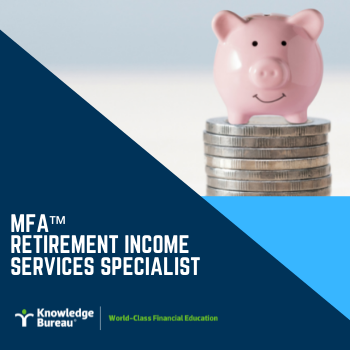Last updated: March 02 2022
Retirement Planning 2022: Time to Rethink It

Evelyn Jacks
When should I tap into the CPP? Should we sell our principal residence? Will my retirement portfolio withstand current market volatility? Canadians who save for retirement are lucky to be assisted in doing so with four key sources of pension income. But these pillars of private financial security, have been subject to tax tinkering recently, as well as valuation swings. It is, as a result, high time to rethink retirement income planning.
Working with a qualified financial advisory team can make all the difference. These collaborative professionals – tax advisors, financial advisors and legal advisors – can help their clients sort through the five pillars of retirement income planning which frame up the options Canadians have in making lifestyle choices in their retirement. These pillars are:
- Public pension plans: the Canada Pension Plan (CPP), which is a mandatory contributory plan for the employed and self-employed in Canada and the Old Age Security (OAS), which is a universal, but income-tested plan for those who reach at 65.
- Employer-sponsored plans, which includes Registered Penson Plans (RPPs), Individual Pension Plans (IPPs) and Personal Pension Plans (PPPs) as well as Deferred Profit Sharing Plans (DPSPs).
- Private pension plans, which include Registered Retirement Savings Plans (RRSPs) and Tax Free Savings Plans (TFSAs)
- Non-registered Savings Plans: These are accounts in which tax-paid capital is invested to earn a variety of income sources including interest, dividends and capital gains, as
 an example. These sources of investment income are subject to different income inclusion rules and marginal tax rates.
an example. These sources of investment income are subject to different income inclusion rules and marginal tax rates. - -financial investments: These include principal residences and other real estate, business and other personal assets.
Taxpayers have different tax reporting requirements with each of these potential retirement income vehicles and this is so both when they are drawing a retirement income and upon the death of the taxpayer. The investment cycles to consider are:
- Accumulation: Saving within the various plans and the deductibility of premiums/contributions
- Growth and Preservation: the best places to grow and withdraw from along the way to retirement
- De-accumulation: Reporting income and offsetting deductions/credits in retirement
- Transition: What happens to these income sources and capital when a taxpayer passes away.
The tax filing and planning needs for a retired taxpayer, generally begin in earnest where at least one taxpayer in the family has reached the age of 55 plus. There are several reasons for this:
- Taxpayers who have reached age 55 and who are members of employer-sponsored Registered Pension Plans may access locked-in plans or participate in phase-in retirement plans.
- These taxpayers may split up to 50% of their income from this source with their spouse;
- In fact, taxpayers at any age who receive retirement benefits from an RPP may split income with a spouse.
- Taxpayers who are eligible for pension income splitting should split at least $2000 to enable the spouse to access the $2000 pension income amount.
- These taxpayers may split up to 50% of their income from this source with their spouse;
- Taxpayers who have reached age 60 may access CPP benefits early
- If both spouses are 60, 50% of these benefits can be assigned to the lower earning spouse.
- Taxpayers who have reached age 65 have several options:
- they can either take or postpone taking their OAS.Postponement to age 70 will result in a 36% increase in the pension, and will absolutely make sense if the taxpayer is still working or
- If still working, they can take CPP retirement benefits but opt-out of paying CPP premiums; electing to invest in a TFSA instead. The survivor benefits are likely better when both spouses worked full time.
- If retiring from employment or self-employment, they may access both CPP and OAS or choose to postpone both these plans to age 70. This makes room for a meltdown of other taxable funds for tax purposes – i.e. RRSP or dividends from a private corporation.
- If withdrawing dividends from a private corporation, a non-active spouse can receive an unlimited amount of these dividends as a form of income splitting
- If withdrawing money from an RRSP or an RRSP converted to a RRIF or annuity, up to 50% of these amounts can be split with the spouse by filing an election to split income (T2032).
- Now taxpayers age 75 and older will be receiving 10% more on their Old Age Security, just under $800. How much of that will they keep as RRIF withdrawals increase with age? It’s a question of concern to higher income earners only, but none-the-less, one to take into account, especially because new retirement savings vehicles, like the ALDA (Advanced Life Deferred Annuity) provide deferral options for those who have reached age 85.
Bottom Line. Things are very different today for pre-and post retirees. Retirement income planning requires a rethink in many cases. The opportunities for pre-retirees are to anticipate the best after-tax consequence in each of four investment cycles in which the options occur, and to do the math with their advisors. The numbers always tell the story.
For these reasons we are asking professionals this month to answer the poll question:
Do you believe the RRSPs is still a good investment for pre-retirees who work past the age of 60?
Additional educational resources: The Tax Efficient Retirement Income Planning course covers a holistic retirement income planning process. You will acquire the knowledge to do a proper assessment of client vision and goals for retirement and engage them in a consistent process for addressing the three trigger questions that cause financial decision-making—life, financial, and economic events.

